Webcomics!
For this week, I read a webcomic called The Meek. Well, I read as much as I could, because it’s still in progress, apparently. But, what I DID read of it reeeeaally sparked my interest!
The story is about a girl who has (so far) unexplained plant-controlling powers, and she’s been sent by her “grandfather,” who disappeared, to save the world from a tyrannical emperor who killed his wife (to appease some beastly tiger demon thing) and waged war on the southern region. The girl’s backstory is told in pieces and hasn’t been established completely because the comic is still in the works, but so far we know that she hasn’t always had her plant-controlling powers.
The first chapter hooked me immediately because for one, the art-style is so beautifully captivating…
And it draws your interest very quickly, because it starts right on intense action! In the beginning of the first chapter, we see a naked girl being chased through a jungle by a group of armed loggers. That left me with so many questions, that I just had to continue reading. When I found out that the naked chick also has awesome, unexplainable superhuman powers, that made the whole situation even cooler, because I’m all about cute chicks with cool powers B)
Not to mention, the universe that the story takes place in is very interesting to me, as well. It feels like some sort of alternate reality, because we see influences things we’d typically find in our world, like similar geographical locations, “technology,” religious concepts, similar earthly cultures and human customs, etc. Despite this, the narrative still has a sense of otherworldliness, because it incorporates inhuman powers, and weird, fantastical creatures and beasts, which I’m certain will appear more in future chapters.
I originally was going to complain about one tiny aspect of this comic, but it quickly made up for itself. My complaint was that after the first chapter, it introduces an entirely different setting with a ton of new characters. It didn’t even feel like the same story. And after THAT chapter, it introduces yet ANOTHER different setting and a bunch of new characters, and seemed to stray further and further away from what the story originally was.
However, halfway through the third chapter, you realize that it’s just establishing all of these new characters separately, and they’re going to come together in the end. It starts to make a LOT more sense after that point.
But, that also sets itself up for being something spectacular, because with all of these characters and the story getting deeper and deeper, putting it together cohesively and in an exciting way make it seem like a massive project…
…I have very high hopes for it, and will DEFINITELY be keeping track of it for later chapters; I’m already following it on social media, heheh!
However, halfway through the third chapter, you realize that it’s just establishing all of these new characters separately, and they’re going to come together in the end. It starts to make a LOT more sense after that point.
But, that also sets itself up for being something spectacular, because with all of these characters and the story getting deeper and deeper, putting it together cohesively and in an exciting way make it seem like a massive project…
…I have very high hopes for it, and will DEFINITELY be keeping track of it for later chapters; I’m already following it on social media, heheh!










